HR Management and Business Performance
VerifiedAdded on 2020/01/07
|14
|4767
|126
Literature Review
AI Summary
This assignment delves into the crucial relationship between human resource management (HRM) strategies, environmental influences, and an organization's overall performance. It requires a critical review of academic literature examining how various HR practices, such as talent acquisition, training & development, and compensation & benefits, contribute to sustained competitive advantage. The analysis also considers the impact of macro-environmental factors and strategic business decisions on HRM effectiveness and organizational success.
Contribute Materials
Your contribution can guide someone’s learning journey. Share your
documents today.
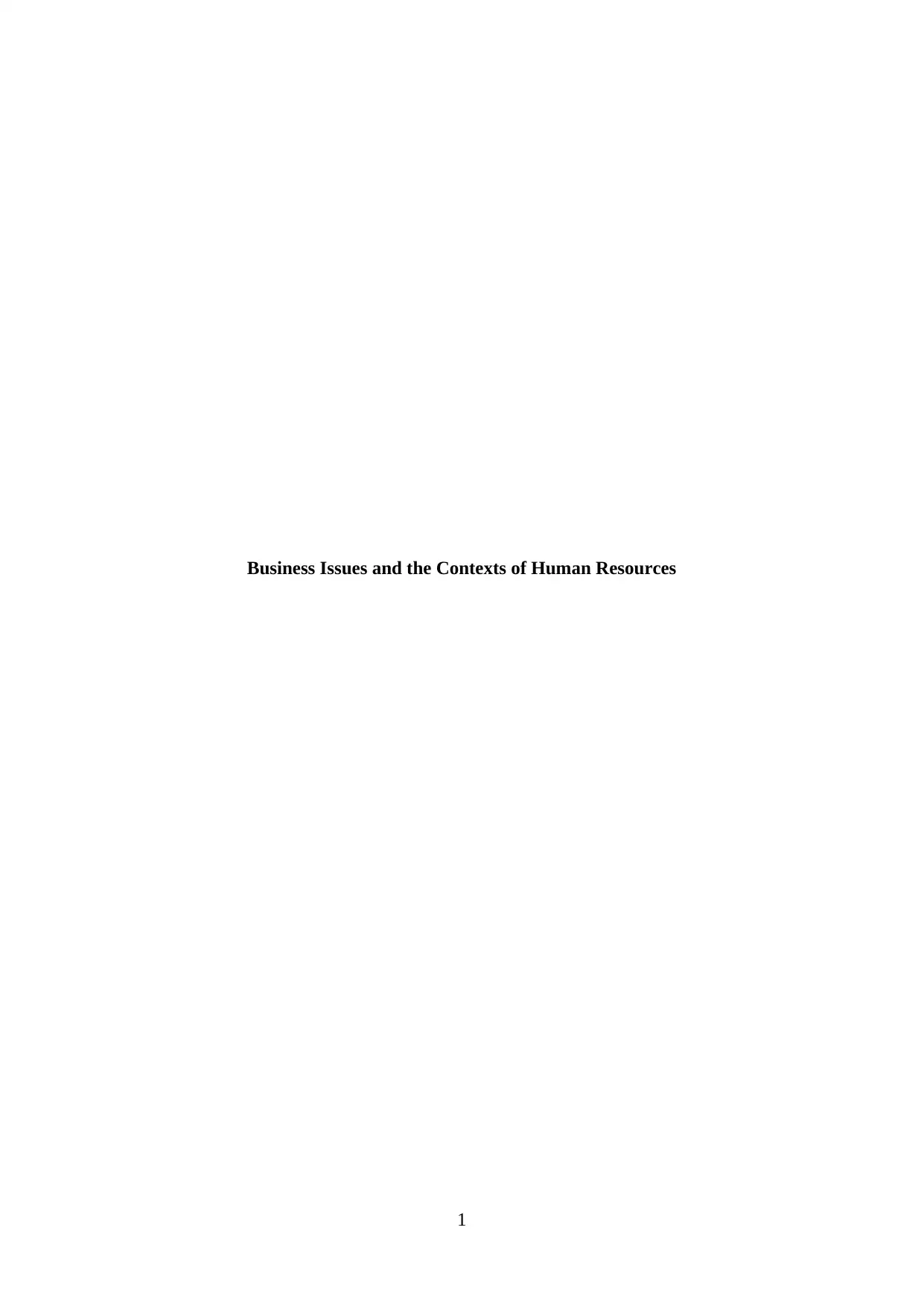
Business Issues and the Contexts of Human Resources
1
1
Secure Best Marks with AI Grader
Need help grading? Try our AI Grader for instant feedback on your assignments.
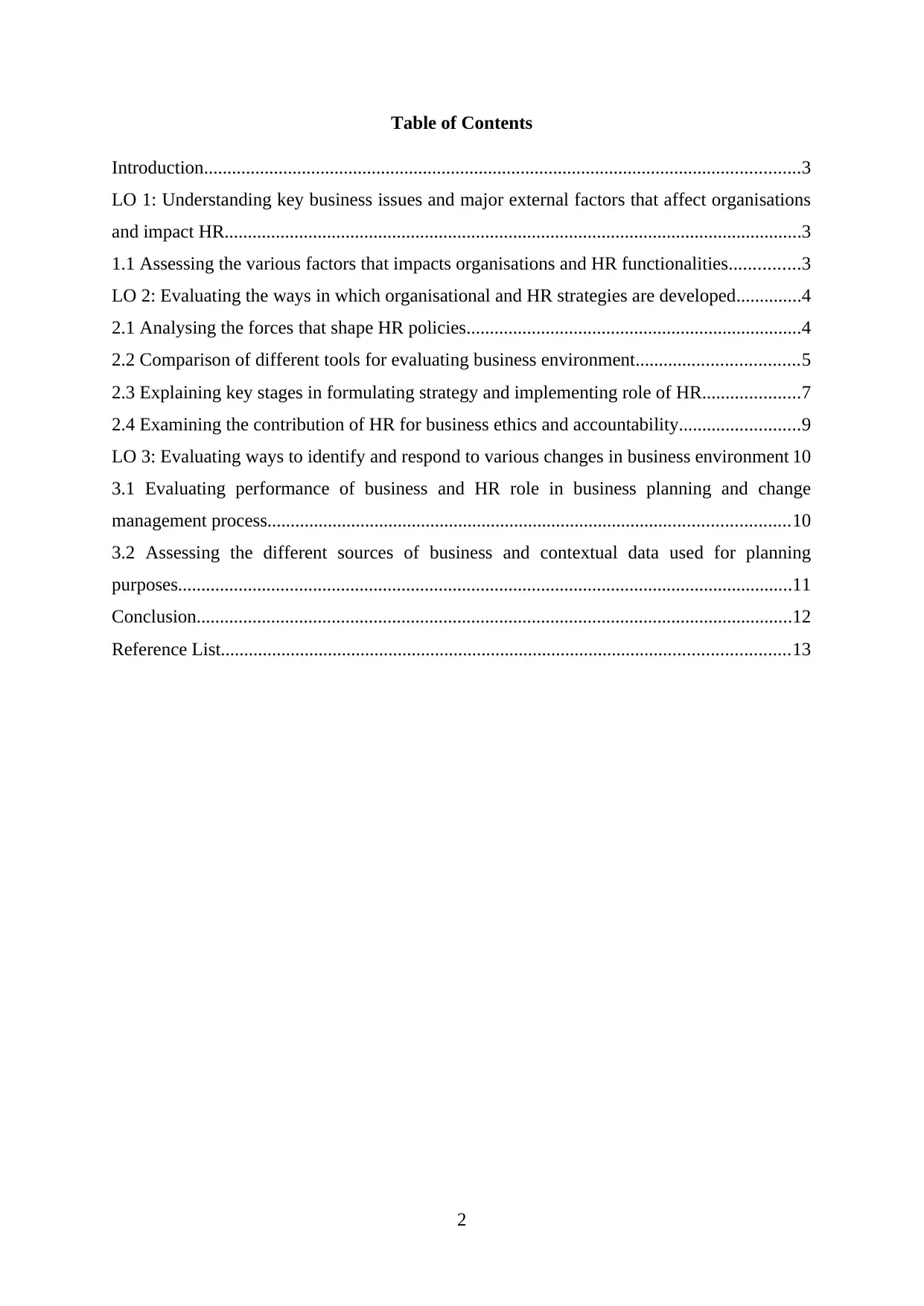
Table of Contents
Introduction................................................................................................................................3
LO 1: Understanding key business issues and major external factors that affect organisations
and impact HR............................................................................................................................3
1.1 Assessing the various factors that impacts organisations and HR functionalities...............3
LO 2: Evaluating the ways in which organisational and HR strategies are developed..............4
2.1 Analysing the forces that shape HR policies........................................................................4
2.2 Comparison of different tools for evaluating business environment...................................5
2.3 Explaining key stages in formulating strategy and implementing role of HR.....................7
2.4 Examining the contribution of HR for business ethics and accountability..........................9
LO 3: Evaluating ways to identify and respond to various changes in business environment 10
3.1 Evaluating performance of business and HR role in business planning and change
management process................................................................................................................10
3.2 Assessing the different sources of business and contextual data used for planning
purposes....................................................................................................................................11
Conclusion................................................................................................................................12
Reference List..........................................................................................................................13
2
Introduction................................................................................................................................3
LO 1: Understanding key business issues and major external factors that affect organisations
and impact HR............................................................................................................................3
1.1 Assessing the various factors that impacts organisations and HR functionalities...............3
LO 2: Evaluating the ways in which organisational and HR strategies are developed..............4
2.1 Analysing the forces that shape HR policies........................................................................4
2.2 Comparison of different tools for evaluating business environment...................................5
2.3 Explaining key stages in formulating strategy and implementing role of HR.....................7
2.4 Examining the contribution of HR for business ethics and accountability..........................9
LO 3: Evaluating ways to identify and respond to various changes in business environment 10
3.1 Evaluating performance of business and HR role in business planning and change
management process................................................................................................................10
3.2 Assessing the different sources of business and contextual data used for planning
purposes....................................................................................................................................11
Conclusion................................................................................................................................12
Reference List..........................................................................................................................13
2
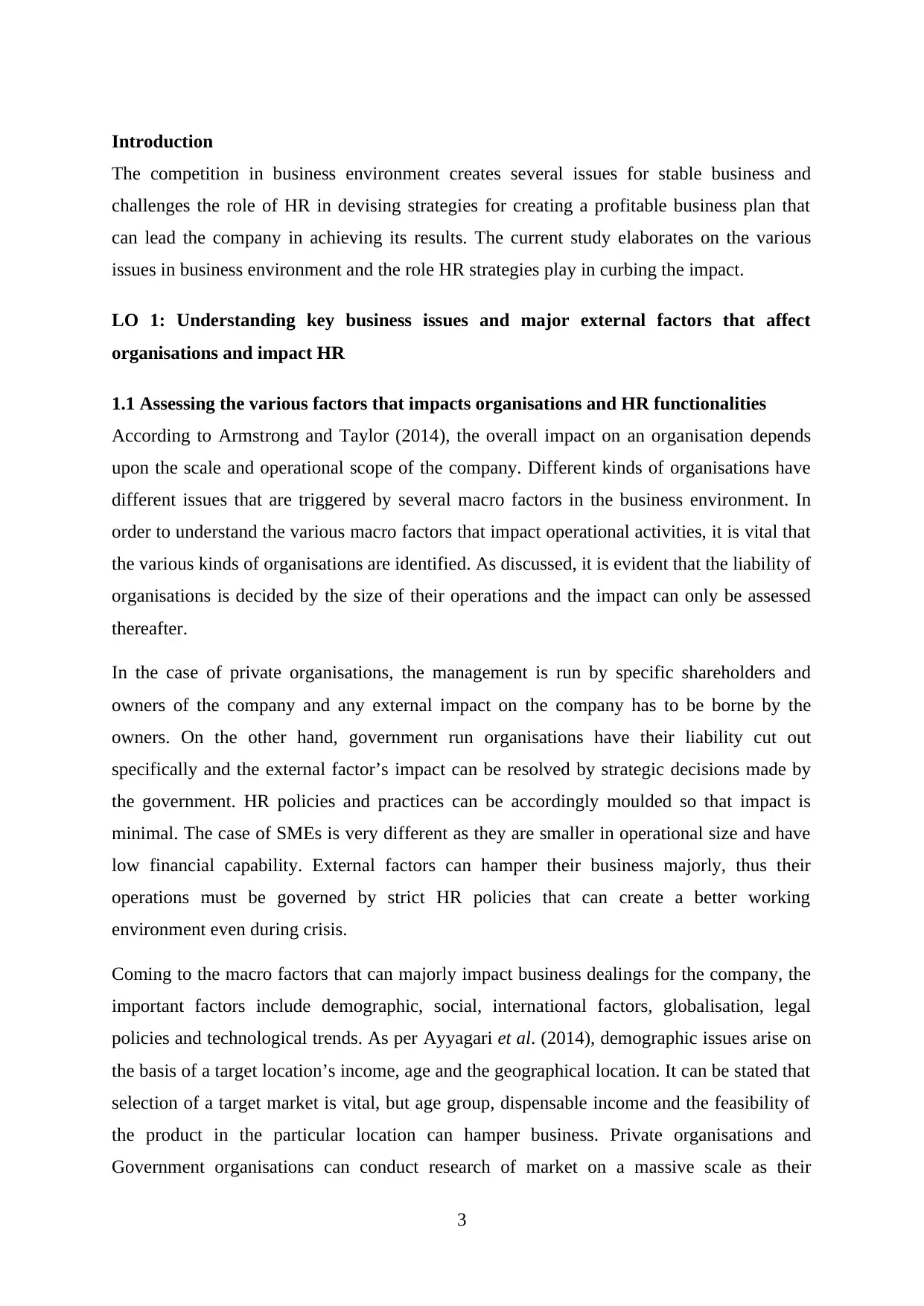
Introduction
The competition in business environment creates several issues for stable business and
challenges the role of HR in devising strategies for creating a profitable business plan that
can lead the company in achieving its results. The current study elaborates on the various
issues in business environment and the role HR strategies play in curbing the impact.
LO 1: Understanding key business issues and major external factors that affect
organisations and impact HR
1.1 Assessing the various factors that impacts organisations and HR functionalities
According to Armstrong and Taylor (2014), the overall impact on an organisation depends
upon the scale and operational scope of the company. Different kinds of organisations have
different issues that are triggered by several macro factors in the business environment. In
order to understand the various macro factors that impact operational activities, it is vital that
the various kinds of organisations are identified. As discussed, it is evident that the liability of
organisations is decided by the size of their operations and the impact can only be assessed
thereafter.
In the case of private organisations, the management is run by specific shareholders and
owners of the company and any external impact on the company has to be borne by the
owners. On the other hand, government run organisations have their liability cut out
specifically and the external factor’s impact can be resolved by strategic decisions made by
the government. HR policies and practices can be accordingly moulded so that impact is
minimal. The case of SMEs is very different as they are smaller in operational size and have
low financial capability. External factors can hamper their business majorly, thus their
operations must be governed by strict HR policies that can create a better working
environment even during crisis.
Coming to the macro factors that can majorly impact business dealings for the company, the
important factors include demographic, social, international factors, globalisation, legal
policies and technological trends. As per Ayyagari et al. (2014), demographic issues arise on
the basis of a target location’s income, age and the geographical location. It can be stated that
selection of a target market is vital, but age group, dispensable income and the feasibility of
the product in the particular location can hamper business. Private organisations and
Government organisations can conduct research of market on a massive scale as their
3
The competition in business environment creates several issues for stable business and
challenges the role of HR in devising strategies for creating a profitable business plan that
can lead the company in achieving its results. The current study elaborates on the various
issues in business environment and the role HR strategies play in curbing the impact.
LO 1: Understanding key business issues and major external factors that affect
organisations and impact HR
1.1 Assessing the various factors that impacts organisations and HR functionalities
According to Armstrong and Taylor (2014), the overall impact on an organisation depends
upon the scale and operational scope of the company. Different kinds of organisations have
different issues that are triggered by several macro factors in the business environment. In
order to understand the various macro factors that impact operational activities, it is vital that
the various kinds of organisations are identified. As discussed, it is evident that the liability of
organisations is decided by the size of their operations and the impact can only be assessed
thereafter.
In the case of private organisations, the management is run by specific shareholders and
owners of the company and any external impact on the company has to be borne by the
owners. On the other hand, government run organisations have their liability cut out
specifically and the external factor’s impact can be resolved by strategic decisions made by
the government. HR policies and practices can be accordingly moulded so that impact is
minimal. The case of SMEs is very different as they are smaller in operational size and have
low financial capability. External factors can hamper their business majorly, thus their
operations must be governed by strict HR policies that can create a better working
environment even during crisis.
Coming to the macro factors that can majorly impact business dealings for the company, the
important factors include demographic, social, international factors, globalisation, legal
policies and technological trends. As per Ayyagari et al. (2014), demographic issues arise on
the basis of a target location’s income, age and the geographical location. It can be stated that
selection of a target market is vital, but age group, dispensable income and the feasibility of
the product in the particular location can hamper business. Private organisations and
Government organisations can conduct research of market on a massive scale as their
3
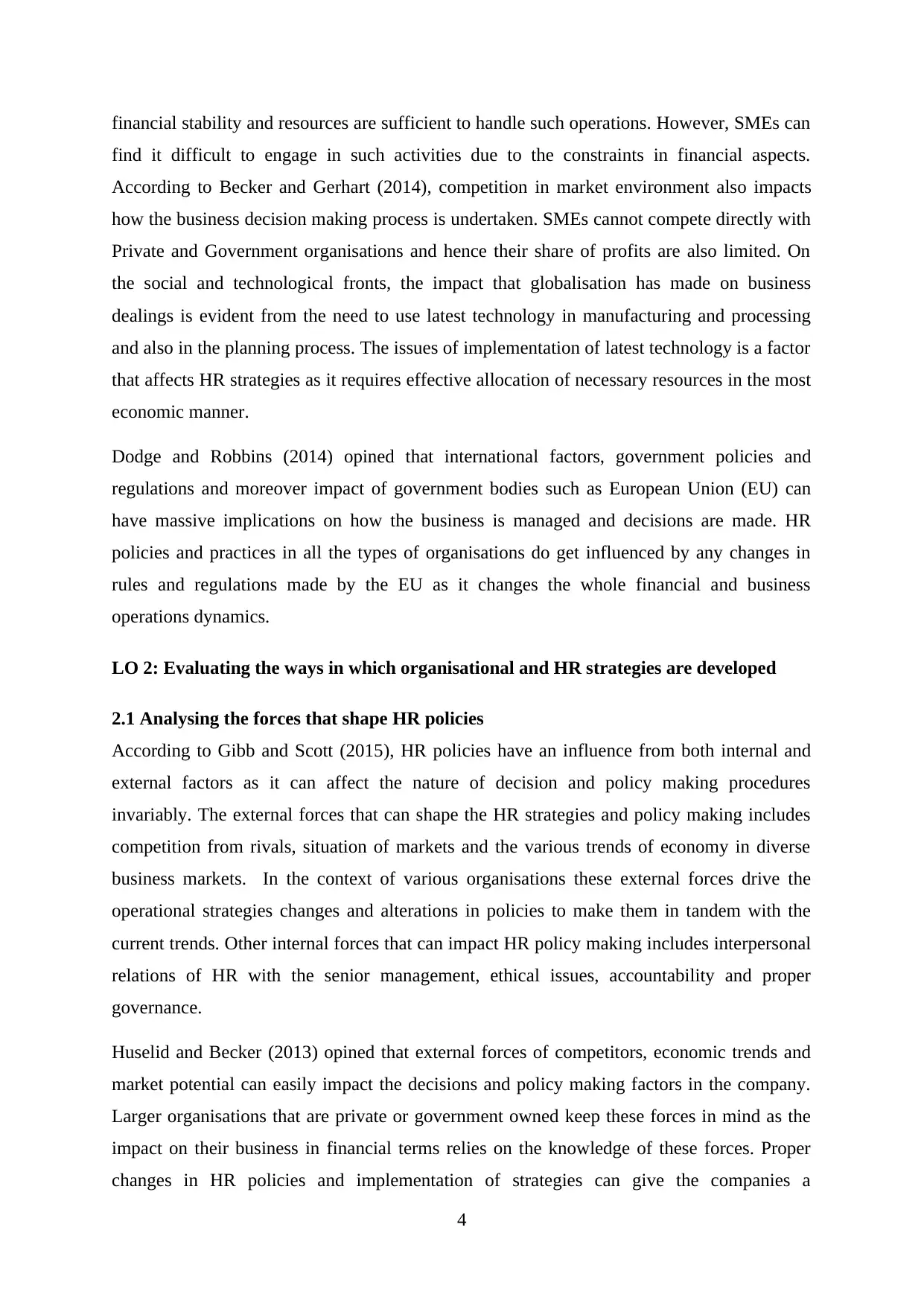
financial stability and resources are sufficient to handle such operations. However, SMEs can
find it difficult to engage in such activities due to the constraints in financial aspects.
According to Becker and Gerhart (2014), competition in market environment also impacts
how the business decision making process is undertaken. SMEs cannot compete directly with
Private and Government organisations and hence their share of profits are also limited. On
the social and technological fronts, the impact that globalisation has made on business
dealings is evident from the need to use latest technology in manufacturing and processing
and also in the planning process. The issues of implementation of latest technology is a factor
that affects HR strategies as it requires effective allocation of necessary resources in the most
economic manner.
Dodge and Robbins (2014) opined that international factors, government policies and
regulations and moreover impact of government bodies such as European Union (EU) can
have massive implications on how the business is managed and decisions are made. HR
policies and practices in all the types of organisations do get influenced by any changes in
rules and regulations made by the EU as it changes the whole financial and business
operations dynamics.
LO 2: Evaluating the ways in which organisational and HR strategies are developed
2.1 Analysing the forces that shape HR policies
According to Gibb and Scott (2015), HR policies have an influence from both internal and
external factors as it can affect the nature of decision and policy making procedures
invariably. The external forces that can shape the HR strategies and policy making includes
competition from rivals, situation of markets and the various trends of economy in diverse
business markets. In the context of various organisations these external forces drive the
operational strategies changes and alterations in policies to make them in tandem with the
current trends. Other internal forces that can impact HR policy making includes interpersonal
relations of HR with the senior management, ethical issues, accountability and proper
governance.
Huselid and Becker (2013) opined that external forces of competitors, economic trends and
market potential can easily impact the decisions and policy making factors in the company.
Larger organisations that are private or government owned keep these forces in mind as the
impact on their business in financial terms relies on the knowledge of these forces. Proper
changes in HR policies and implementation of strategies can give the companies a
4
find it difficult to engage in such activities due to the constraints in financial aspects.
According to Becker and Gerhart (2014), competition in market environment also impacts
how the business decision making process is undertaken. SMEs cannot compete directly with
Private and Government organisations and hence their share of profits are also limited. On
the social and technological fronts, the impact that globalisation has made on business
dealings is evident from the need to use latest technology in manufacturing and processing
and also in the planning process. The issues of implementation of latest technology is a factor
that affects HR strategies as it requires effective allocation of necessary resources in the most
economic manner.
Dodge and Robbins (2014) opined that international factors, government policies and
regulations and moreover impact of government bodies such as European Union (EU) can
have massive implications on how the business is managed and decisions are made. HR
policies and practices in all the types of organisations do get influenced by any changes in
rules and regulations made by the EU as it changes the whole financial and business
operations dynamics.
LO 2: Evaluating the ways in which organisational and HR strategies are developed
2.1 Analysing the forces that shape HR policies
According to Gibb and Scott (2015), HR policies have an influence from both internal and
external factors as it can affect the nature of decision and policy making procedures
invariably. The external forces that can shape the HR strategies and policy making includes
competition from rivals, situation of markets and the various trends of economy in diverse
business markets. In the context of various organisations these external forces drive the
operational strategies changes and alterations in policies to make them in tandem with the
current trends. Other internal forces that can impact HR policy making includes interpersonal
relations of HR with the senior management, ethical issues, accountability and proper
governance.
Huselid and Becker (2013) opined that external forces of competitors, economic trends and
market potential can easily impact the decisions and policy making factors in the company.
Larger organisations that are private or government owned keep these forces in mind as the
impact on their business in financial terms relies on the knowledge of these forces. Proper
changes in HR policies and implementation of strategies can give the companies a
4
Secure Best Marks with AI Grader
Need help grading? Try our AI Grader for instant feedback on your assignments.
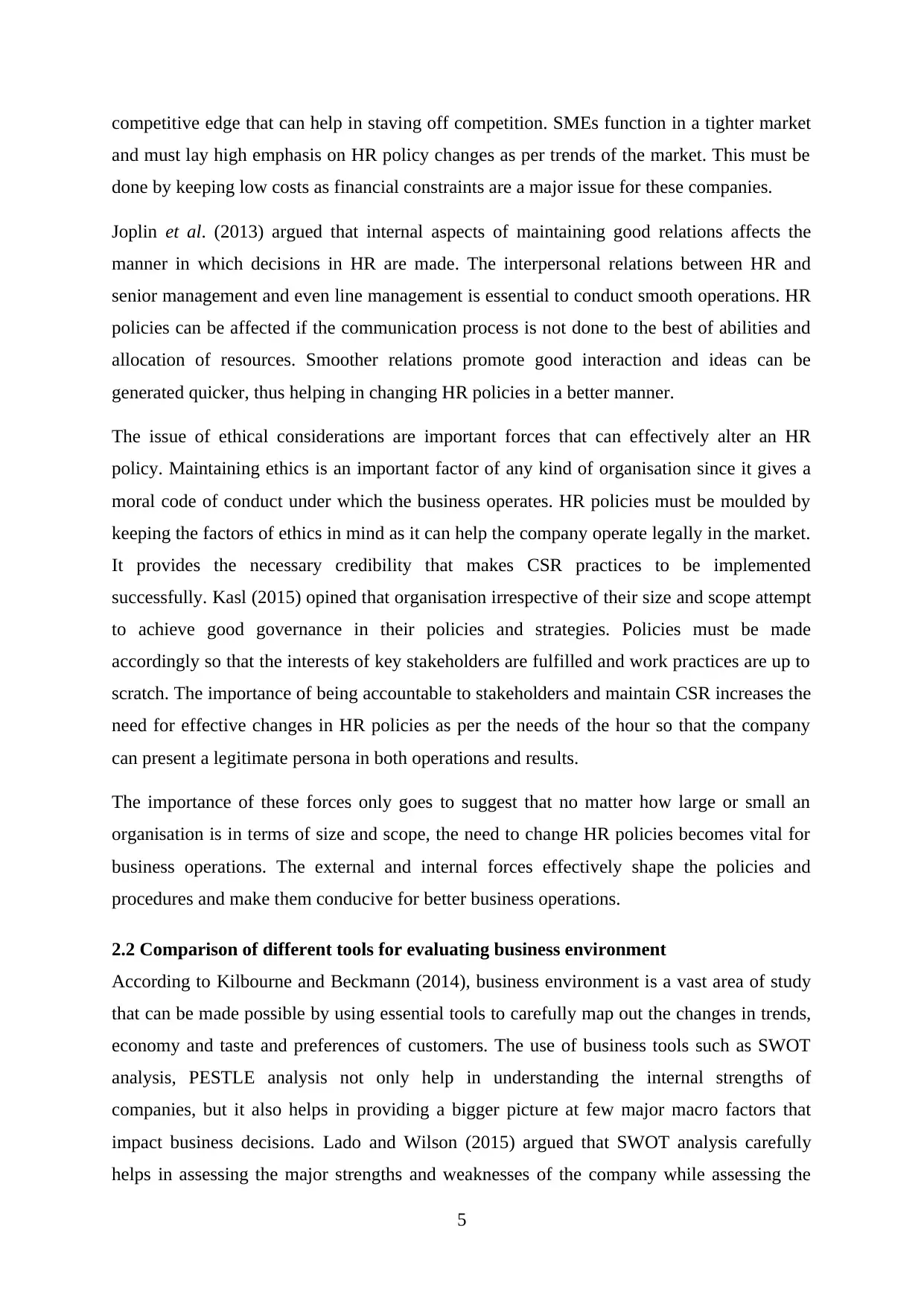
competitive edge that can help in staving off competition. SMEs function in a tighter market
and must lay high emphasis on HR policy changes as per trends of the market. This must be
done by keeping low costs as financial constraints are a major issue for these companies.
Joplin et al. (2013) argued that internal aspects of maintaining good relations affects the
manner in which decisions in HR are made. The interpersonal relations between HR and
senior management and even line management is essential to conduct smooth operations. HR
policies can be affected if the communication process is not done to the best of abilities and
allocation of resources. Smoother relations promote good interaction and ideas can be
generated quicker, thus helping in changing HR policies in a better manner.
The issue of ethical considerations are important forces that can effectively alter an HR
policy. Maintaining ethics is an important factor of any kind of organisation since it gives a
moral code of conduct under which the business operates. HR policies must be moulded by
keeping the factors of ethics in mind as it can help the company operate legally in the market.
It provides the necessary credibility that makes CSR practices to be implemented
successfully. Kasl (2015) opined that organisation irrespective of their size and scope attempt
to achieve good governance in their policies and strategies. Policies must be made
accordingly so that the interests of key stakeholders are fulfilled and work practices are up to
scratch. The importance of being accountable to stakeholders and maintain CSR increases the
need for effective changes in HR policies as per the needs of the hour so that the company
can present a legitimate persona in both operations and results.
The importance of these forces only goes to suggest that no matter how large or small an
organisation is in terms of size and scope, the need to change HR policies becomes vital for
business operations. The external and internal forces effectively shape the policies and
procedures and make them conducive for better business operations.
2.2 Comparison of different tools for evaluating business environment
According to Kilbourne and Beckmann (2014), business environment is a vast area of study
that can be made possible by using essential tools to carefully map out the changes in trends,
economy and taste and preferences of customers. The use of business tools such as SWOT
analysis, PESTLE analysis not only help in understanding the internal strengths of
companies, but it also helps in providing a bigger picture at few major macro factors that
impact business decisions. Lado and Wilson (2015) argued that SWOT analysis carefully
helps in assessing the major strengths and weaknesses of the company while assessing the
5
and must lay high emphasis on HR policy changes as per trends of the market. This must be
done by keeping low costs as financial constraints are a major issue for these companies.
Joplin et al. (2013) argued that internal aspects of maintaining good relations affects the
manner in which decisions in HR are made. The interpersonal relations between HR and
senior management and even line management is essential to conduct smooth operations. HR
policies can be affected if the communication process is not done to the best of abilities and
allocation of resources. Smoother relations promote good interaction and ideas can be
generated quicker, thus helping in changing HR policies in a better manner.
The issue of ethical considerations are important forces that can effectively alter an HR
policy. Maintaining ethics is an important factor of any kind of organisation since it gives a
moral code of conduct under which the business operates. HR policies must be moulded by
keeping the factors of ethics in mind as it can help the company operate legally in the market.
It provides the necessary credibility that makes CSR practices to be implemented
successfully. Kasl (2015) opined that organisation irrespective of their size and scope attempt
to achieve good governance in their policies and strategies. Policies must be made
accordingly so that the interests of key stakeholders are fulfilled and work practices are up to
scratch. The importance of being accountable to stakeholders and maintain CSR increases the
need for effective changes in HR policies as per the needs of the hour so that the company
can present a legitimate persona in both operations and results.
The importance of these forces only goes to suggest that no matter how large or small an
organisation is in terms of size and scope, the need to change HR policies becomes vital for
business operations. The external and internal forces effectively shape the policies and
procedures and make them conducive for better business operations.
2.2 Comparison of different tools for evaluating business environment
According to Kilbourne and Beckmann (2014), business environment is a vast area of study
that can be made possible by using essential tools to carefully map out the changes in trends,
economy and taste and preferences of customers. The use of business tools such as SWOT
analysis, PESTLE analysis not only help in understanding the internal strengths of
companies, but it also helps in providing a bigger picture at few major macro factors that
impact business decisions. Lado and Wilson (2015) argued that SWOT analysis carefully
helps in assessing the major strengths and weaknesses of the company while assessing the
5
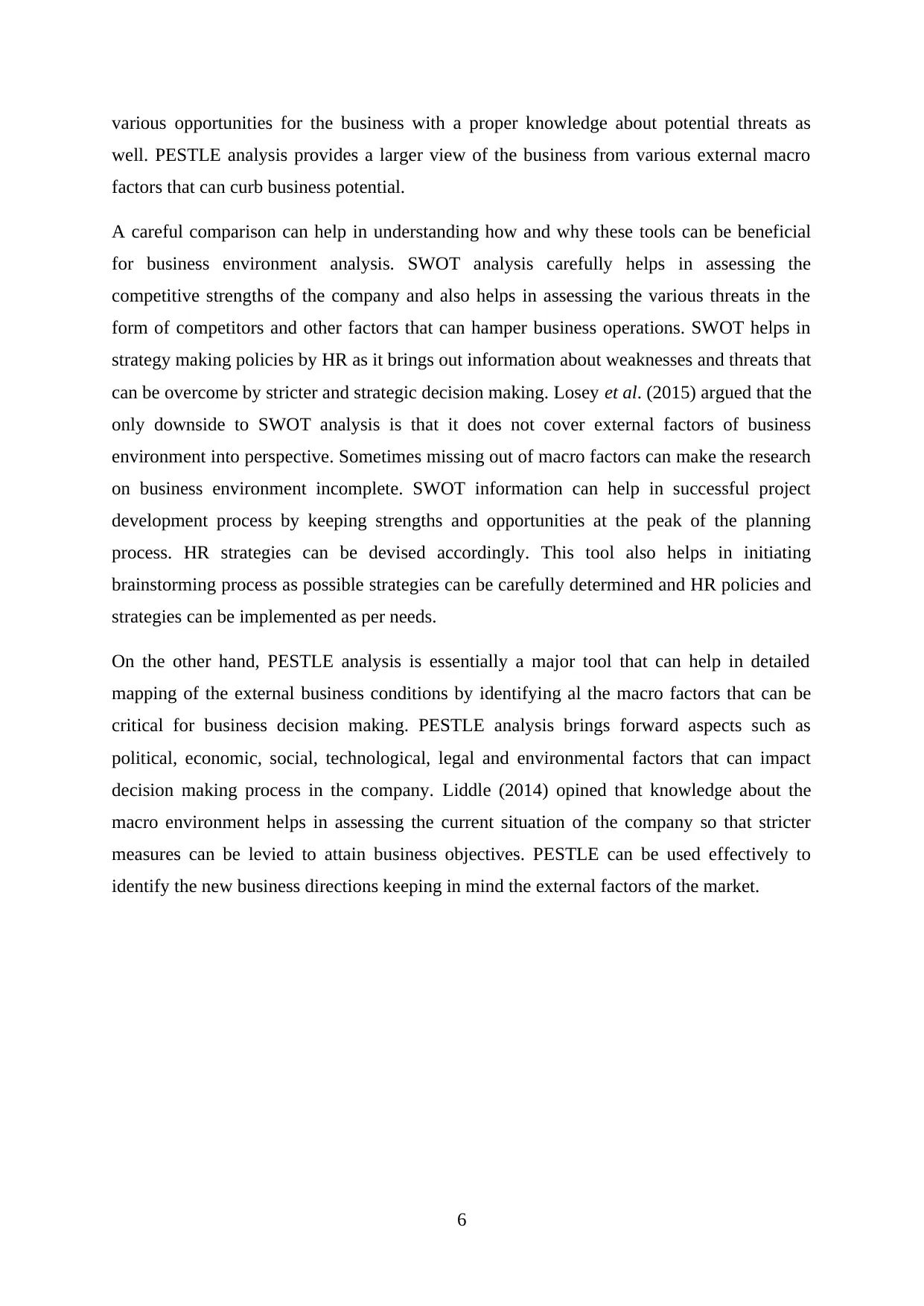
various opportunities for the business with a proper knowledge about potential threats as
well. PESTLE analysis provides a larger view of the business from various external macro
factors that can curb business potential.
A careful comparison can help in understanding how and why these tools can be beneficial
for business environment analysis. SWOT analysis carefully helps in assessing the
competitive strengths of the company and also helps in assessing the various threats in the
form of competitors and other factors that can hamper business operations. SWOT helps in
strategy making policies by HR as it brings out information about weaknesses and threats that
can be overcome by stricter and strategic decision making. Losey et al. (2015) argued that the
only downside to SWOT analysis is that it does not cover external factors of business
environment into perspective. Sometimes missing out of macro factors can make the research
on business environment incomplete. SWOT information can help in successful project
development process by keeping strengths and opportunities at the peak of the planning
process. HR strategies can be devised accordingly. This tool also helps in initiating
brainstorming process as possible strategies can be carefully determined and HR policies and
strategies can be implemented as per needs.
On the other hand, PESTLE analysis is essentially a major tool that can help in detailed
mapping of the external business conditions by identifying al the macro factors that can be
critical for business decision making. PESTLE analysis brings forward aspects such as
political, economic, social, technological, legal and environmental factors that can impact
decision making process in the company. Liddle (2014) opined that knowledge about the
macro environment helps in assessing the current situation of the company so that stricter
measures can be levied to attain business objectives. PESTLE can be used effectively to
identify the new business directions keeping in mind the external factors of the market.
6
well. PESTLE analysis provides a larger view of the business from various external macro
factors that can curb business potential.
A careful comparison can help in understanding how and why these tools can be beneficial
for business environment analysis. SWOT analysis carefully helps in assessing the
competitive strengths of the company and also helps in assessing the various threats in the
form of competitors and other factors that can hamper business operations. SWOT helps in
strategy making policies by HR as it brings out information about weaknesses and threats that
can be overcome by stricter and strategic decision making. Losey et al. (2015) argued that the
only downside to SWOT analysis is that it does not cover external factors of business
environment into perspective. Sometimes missing out of macro factors can make the research
on business environment incomplete. SWOT information can help in successful project
development process by keeping strengths and opportunities at the peak of the planning
process. HR strategies can be devised accordingly. This tool also helps in initiating
brainstorming process as possible strategies can be carefully determined and HR policies and
strategies can be implemented as per needs.
On the other hand, PESTLE analysis is essentially a major tool that can help in detailed
mapping of the external business conditions by identifying al the macro factors that can be
critical for business decision making. PESTLE analysis brings forward aspects such as
political, economic, social, technological, legal and environmental factors that can impact
decision making process in the company. Liddle (2014) opined that knowledge about the
macro environment helps in assessing the current situation of the company so that stricter
measures can be levied to attain business objectives. PESTLE can be used effectively to
identify the new business directions keeping in mind the external factors of the market.
6
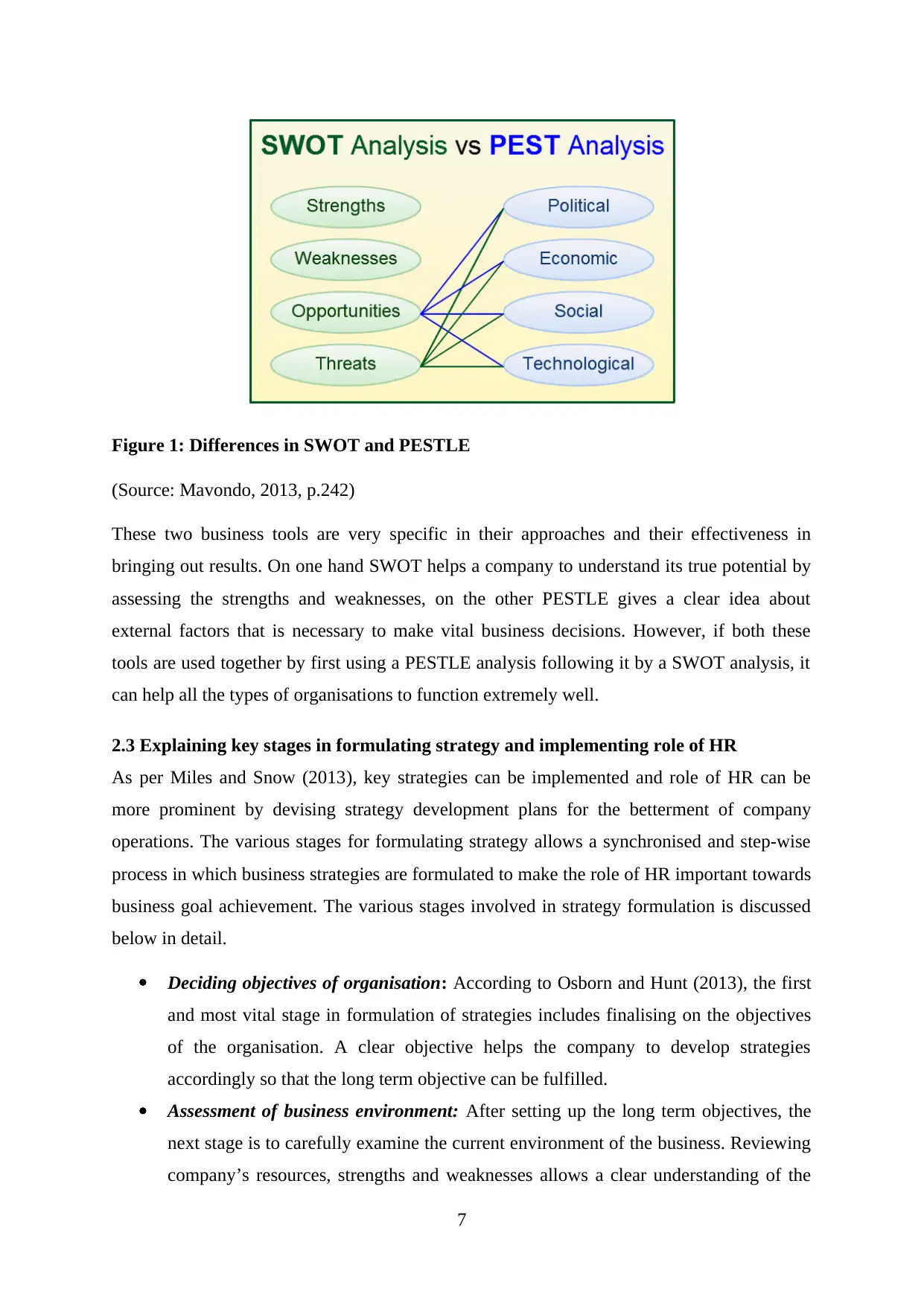
Figure 1: Differences in SWOT and PESTLE
(Source: Mavondo, 2013, p.242)
These two business tools are very specific in their approaches and their effectiveness in
bringing out results. On one hand SWOT helps a company to understand its true potential by
assessing the strengths and weaknesses, on the other PESTLE gives a clear idea about
external factors that is necessary to make vital business decisions. However, if both these
tools are used together by first using a PESTLE analysis following it by a SWOT analysis, it
can help all the types of organisations to function extremely well.
2.3 Explaining key stages in formulating strategy and implementing role of HR
As per Miles and Snow (2013), key strategies can be implemented and role of HR can be
more prominent by devising strategy development plans for the betterment of company
operations. The various stages for formulating strategy allows a synchronised and step-wise
process in which business strategies are formulated to make the role of HR important towards
business goal achievement. The various stages involved in strategy formulation is discussed
below in detail.
Deciding objectives of organisation: According to Osborn and Hunt (2013), the first
and most vital stage in formulation of strategies includes finalising on the objectives
of the organisation. A clear objective helps the company to develop strategies
accordingly so that the long term objective can be fulfilled.
Assessment of business environment: After setting up the long term objectives, the
next stage is to carefully examine the current environment of the business. Reviewing
company’s resources, strengths and weaknesses allows a clear understanding of the
7
(Source: Mavondo, 2013, p.242)
These two business tools are very specific in their approaches and their effectiveness in
bringing out results. On one hand SWOT helps a company to understand its true potential by
assessing the strengths and weaknesses, on the other PESTLE gives a clear idea about
external factors that is necessary to make vital business decisions. However, if both these
tools are used together by first using a PESTLE analysis following it by a SWOT analysis, it
can help all the types of organisations to function extremely well.
2.3 Explaining key stages in formulating strategy and implementing role of HR
As per Miles and Snow (2013), key strategies can be implemented and role of HR can be
more prominent by devising strategy development plans for the betterment of company
operations. The various stages for formulating strategy allows a synchronised and step-wise
process in which business strategies are formulated to make the role of HR important towards
business goal achievement. The various stages involved in strategy formulation is discussed
below in detail.
Deciding objectives of organisation: According to Osborn and Hunt (2013), the first
and most vital stage in formulation of strategies includes finalising on the objectives
of the organisation. A clear objective helps the company to develop strategies
accordingly so that the long term objective can be fulfilled.
Assessment of business environment: After setting up the long term objectives, the
next stage is to carefully examine the current environment of the business. Reviewing
company’s resources, strengths and weaknesses allows a clear understanding of the
7
Paraphrase This Document
Need a fresh take? Get an instant paraphrase of this document with our AI Paraphraser
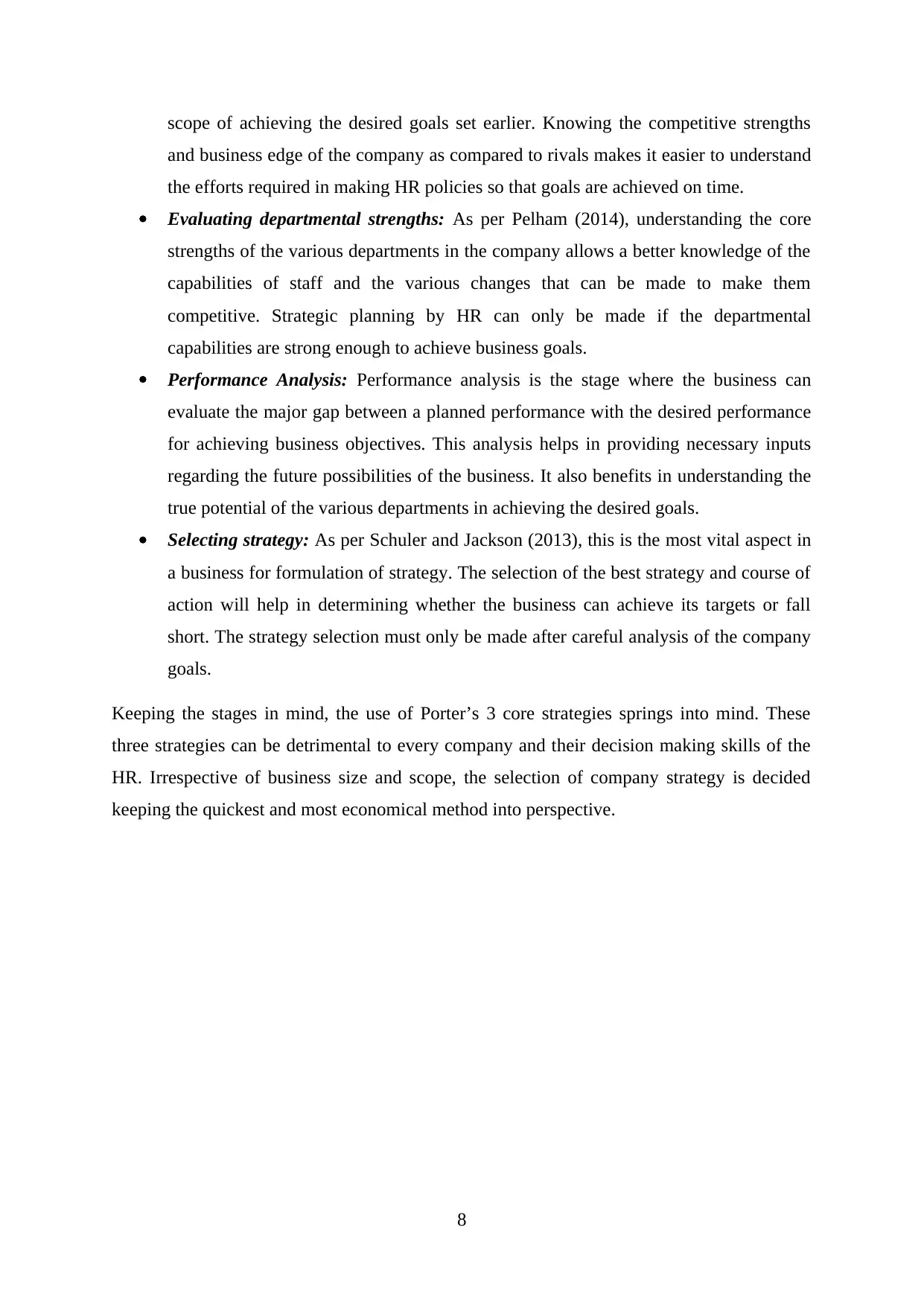
scope of achieving the desired goals set earlier. Knowing the competitive strengths
and business edge of the company as compared to rivals makes it easier to understand
the efforts required in making HR policies so that goals are achieved on time.
Evaluating departmental strengths: As per Pelham (2014), understanding the core
strengths of the various departments in the company allows a better knowledge of the
capabilities of staff and the various changes that can be made to make them
competitive. Strategic planning by HR can only be made if the departmental
capabilities are strong enough to achieve business goals.
Performance Analysis: Performance analysis is the stage where the business can
evaluate the major gap between a planned performance with the desired performance
for achieving business objectives. This analysis helps in providing necessary inputs
regarding the future possibilities of the business. It also benefits in understanding the
true potential of the various departments in achieving the desired goals.
Selecting strategy: As per Schuler and Jackson (2013), this is the most vital aspect in
a business for formulation of strategy. The selection of the best strategy and course of
action will help in determining whether the business can achieve its targets or fall
short. The strategy selection must only be made after careful analysis of the company
goals.
Keeping the stages in mind, the use of Porter’s 3 core strategies springs into mind. These
three strategies can be detrimental to every company and their decision making skills of the
HR. Irrespective of business size and scope, the selection of company strategy is decided
keeping the quickest and most economical method into perspective.
8
and business edge of the company as compared to rivals makes it easier to understand
the efforts required in making HR policies so that goals are achieved on time.
Evaluating departmental strengths: As per Pelham (2014), understanding the core
strengths of the various departments in the company allows a better knowledge of the
capabilities of staff and the various changes that can be made to make them
competitive. Strategic planning by HR can only be made if the departmental
capabilities are strong enough to achieve business goals.
Performance Analysis: Performance analysis is the stage where the business can
evaluate the major gap between a planned performance with the desired performance
for achieving business objectives. This analysis helps in providing necessary inputs
regarding the future possibilities of the business. It also benefits in understanding the
true potential of the various departments in achieving the desired goals.
Selecting strategy: As per Schuler and Jackson (2013), this is the most vital aspect in
a business for formulation of strategy. The selection of the best strategy and course of
action will help in determining whether the business can achieve its targets or fall
short. The strategy selection must only be made after careful analysis of the company
goals.
Keeping the stages in mind, the use of Porter’s 3 core strategies springs into mind. These
three strategies can be detrimental to every company and their decision making skills of the
HR. Irrespective of business size and scope, the selection of company strategy is decided
keeping the quickest and most economical method into perspective.
8
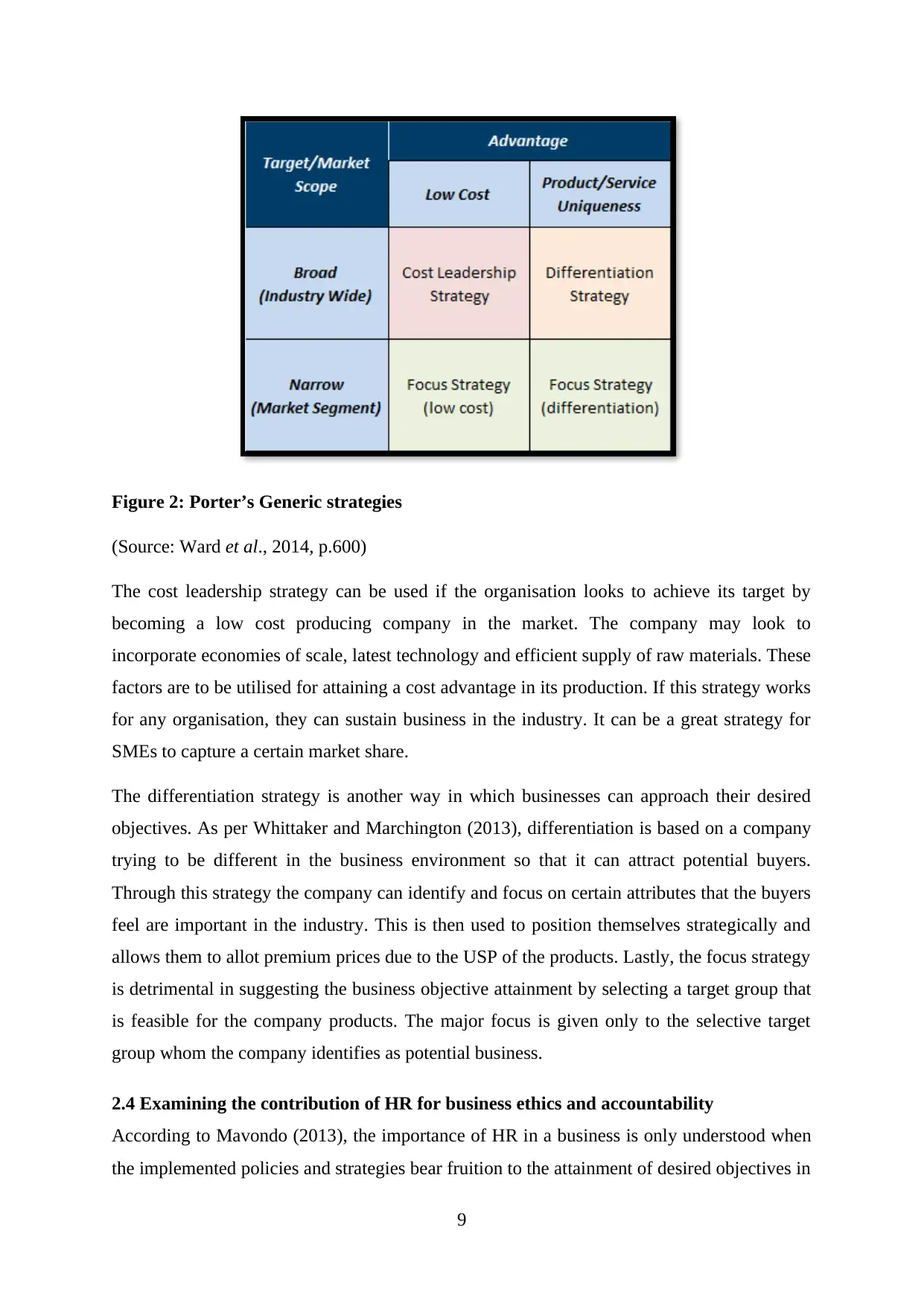
Figure 2: Porter’s Generic strategies
(Source: Ward et al., 2014, p.600)
The cost leadership strategy can be used if the organisation looks to achieve its target by
becoming a low cost producing company in the market. The company may look to
incorporate economies of scale, latest technology and efficient supply of raw materials. These
factors are to be utilised for attaining a cost advantage in its production. If this strategy works
for any organisation, they can sustain business in the industry. It can be a great strategy for
SMEs to capture a certain market share.
The differentiation strategy is another way in which businesses can approach their desired
objectives. As per Whittaker and Marchington (2013), differentiation is based on a company
trying to be different in the business environment so that it can attract potential buyers.
Through this strategy the company can identify and focus on certain attributes that the buyers
feel are important in the industry. This is then used to position themselves strategically and
allows them to allot premium prices due to the USP of the products. Lastly, the focus strategy
is detrimental in suggesting the business objective attainment by selecting a target group that
is feasible for the company products. The major focus is given only to the selective target
group whom the company identifies as potential business.
2.4 Examining the contribution of HR for business ethics and accountability
According to Mavondo (2013), the importance of HR in a business is only understood when
the implemented policies and strategies bear fruition to the attainment of desired objectives in
9
(Source: Ward et al., 2014, p.600)
The cost leadership strategy can be used if the organisation looks to achieve its target by
becoming a low cost producing company in the market. The company may look to
incorporate economies of scale, latest technology and efficient supply of raw materials. These
factors are to be utilised for attaining a cost advantage in its production. If this strategy works
for any organisation, they can sustain business in the industry. It can be a great strategy for
SMEs to capture a certain market share.
The differentiation strategy is another way in which businesses can approach their desired
objectives. As per Whittaker and Marchington (2013), differentiation is based on a company
trying to be different in the business environment so that it can attract potential buyers.
Through this strategy the company can identify and focus on certain attributes that the buyers
feel are important in the industry. This is then used to position themselves strategically and
allows them to allot premium prices due to the USP of the products. Lastly, the focus strategy
is detrimental in suggesting the business objective attainment by selecting a target group that
is feasible for the company products. The major focus is given only to the selective target
group whom the company identifies as potential business.
2.4 Examining the contribution of HR for business ethics and accountability
According to Mavondo (2013), the importance of HR in a business is only understood when
the implemented policies and strategies bear fruition to the attainment of desired objectives in
9
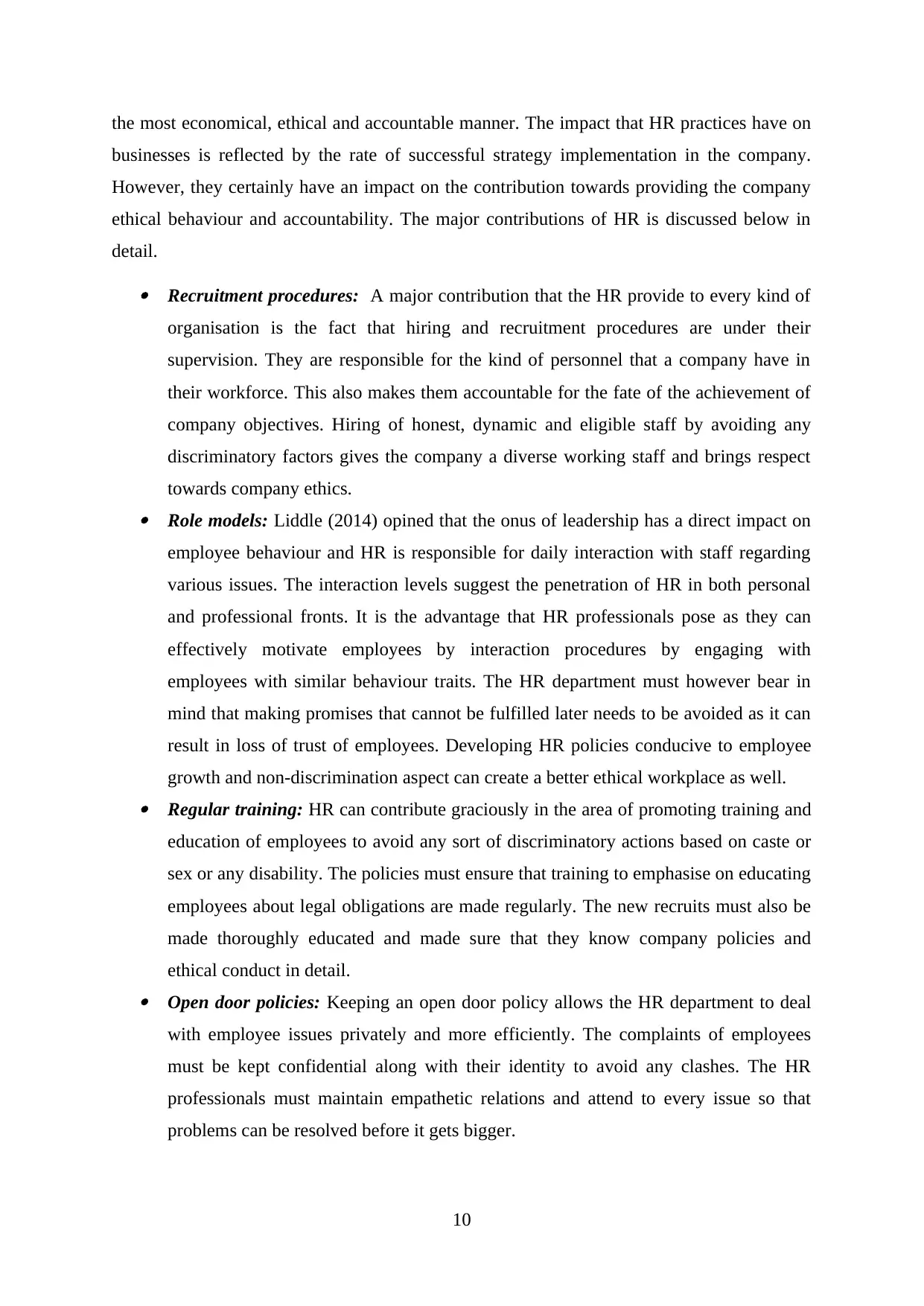
the most economical, ethical and accountable manner. The impact that HR practices have on
businesses is reflected by the rate of successful strategy implementation in the company.
However, they certainly have an impact on the contribution towards providing the company
ethical behaviour and accountability. The major contributions of HR is discussed below in
detail. Recruitment procedures: A major contribution that the HR provide to every kind of
organisation is the fact that hiring and recruitment procedures are under their
supervision. They are responsible for the kind of personnel that a company have in
their workforce. This also makes them accountable for the fate of the achievement of
company objectives. Hiring of honest, dynamic and eligible staff by avoiding any
discriminatory factors gives the company a diverse working staff and brings respect
towards company ethics. Role models: Liddle (2014) opined that the onus of leadership has a direct impact on
employee behaviour and HR is responsible for daily interaction with staff regarding
various issues. The interaction levels suggest the penetration of HR in both personal
and professional fronts. It is the advantage that HR professionals pose as they can
effectively motivate employees by interaction procedures by engaging with
employees with similar behaviour traits. The HR department must however bear in
mind that making promises that cannot be fulfilled later needs to be avoided as it can
result in loss of trust of employees. Developing HR policies conducive to employee
growth and non-discrimination aspect can create a better ethical workplace as well. Regular training: HR can contribute graciously in the area of promoting training and
education of employees to avoid any sort of discriminatory actions based on caste or
sex or any disability. The policies must ensure that training to emphasise on educating
employees about legal obligations are made regularly. The new recruits must also be
made thoroughly educated and made sure that they know company policies and
ethical conduct in detail. Open door policies: Keeping an open door policy allows the HR department to deal
with employee issues privately and more efficiently. The complaints of employees
must be kept confidential along with their identity to avoid any clashes. The HR
professionals must maintain empathetic relations and attend to every issue so that
problems can be resolved before it gets bigger.
10
businesses is reflected by the rate of successful strategy implementation in the company.
However, they certainly have an impact on the contribution towards providing the company
ethical behaviour and accountability. The major contributions of HR is discussed below in
detail. Recruitment procedures: A major contribution that the HR provide to every kind of
organisation is the fact that hiring and recruitment procedures are under their
supervision. They are responsible for the kind of personnel that a company have in
their workforce. This also makes them accountable for the fate of the achievement of
company objectives. Hiring of honest, dynamic and eligible staff by avoiding any
discriminatory factors gives the company a diverse working staff and brings respect
towards company ethics. Role models: Liddle (2014) opined that the onus of leadership has a direct impact on
employee behaviour and HR is responsible for daily interaction with staff regarding
various issues. The interaction levels suggest the penetration of HR in both personal
and professional fronts. It is the advantage that HR professionals pose as they can
effectively motivate employees by interaction procedures by engaging with
employees with similar behaviour traits. The HR department must however bear in
mind that making promises that cannot be fulfilled later needs to be avoided as it can
result in loss of trust of employees. Developing HR policies conducive to employee
growth and non-discrimination aspect can create a better ethical workplace as well. Regular training: HR can contribute graciously in the area of promoting training and
education of employees to avoid any sort of discriminatory actions based on caste or
sex or any disability. The policies must ensure that training to emphasise on educating
employees about legal obligations are made regularly. The new recruits must also be
made thoroughly educated and made sure that they know company policies and
ethical conduct in detail. Open door policies: Keeping an open door policy allows the HR department to deal
with employee issues privately and more efficiently. The complaints of employees
must be kept confidential along with their identity to avoid any clashes. The HR
professionals must maintain empathetic relations and attend to every issue so that
problems can be resolved before it gets bigger.
10
Secure Best Marks with AI Grader
Need help grading? Try our AI Grader for instant feedback on your assignments.
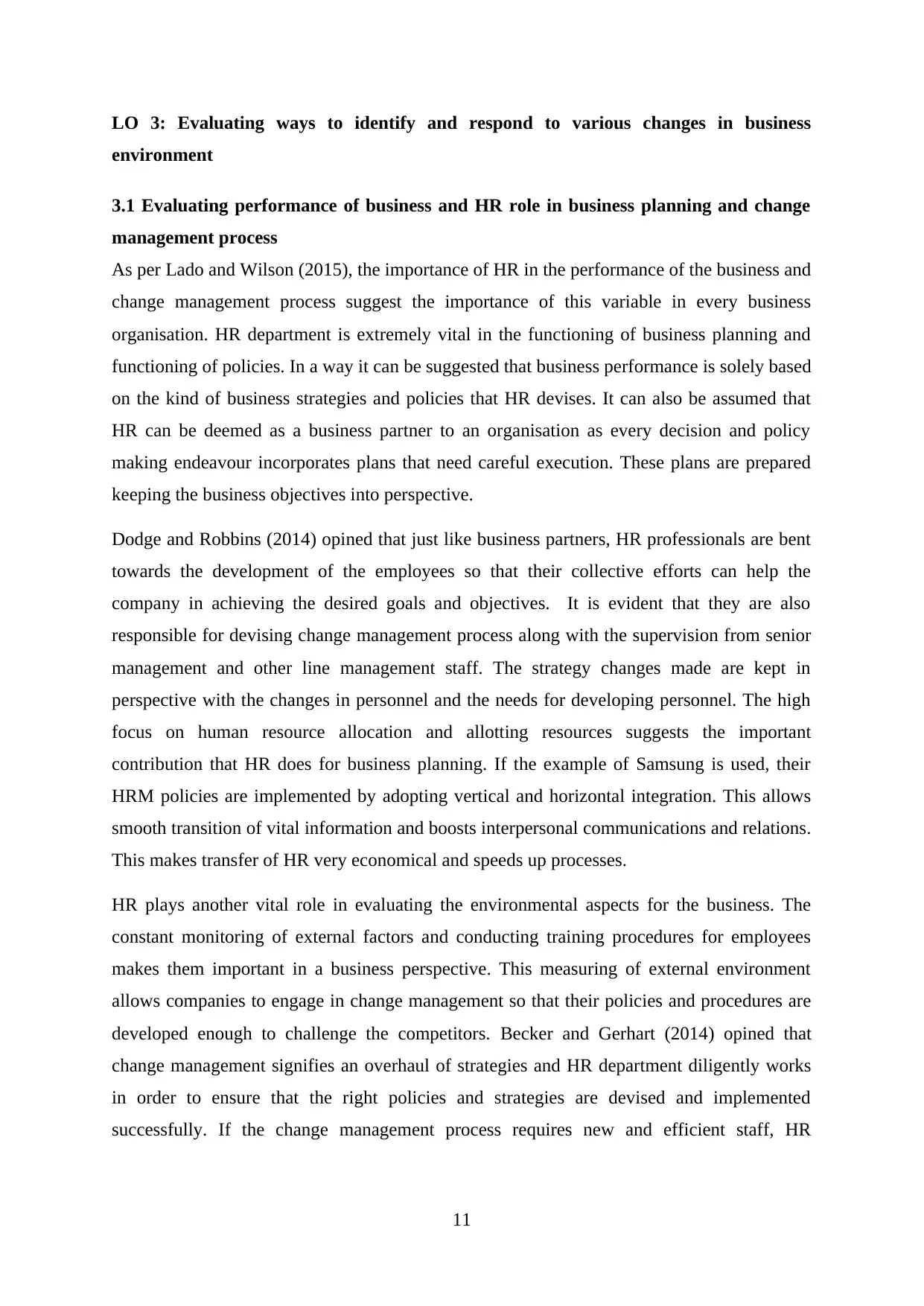
LO 3: Evaluating ways to identify and respond to various changes in business
environment
3.1 Evaluating performance of business and HR role in business planning and change
management process
As per Lado and Wilson (2015), the importance of HR in the performance of the business and
change management process suggest the importance of this variable in every business
organisation. HR department is extremely vital in the functioning of business planning and
functioning of policies. In a way it can be suggested that business performance is solely based
on the kind of business strategies and policies that HR devises. It can also be assumed that
HR can be deemed as a business partner to an organisation as every decision and policy
making endeavour incorporates plans that need careful execution. These plans are prepared
keeping the business objectives into perspective.
Dodge and Robbins (2014) opined that just like business partners, HR professionals are bent
towards the development of the employees so that their collective efforts can help the
company in achieving the desired goals and objectives. It is evident that they are also
responsible for devising change management process along with the supervision from senior
management and other line management staff. The strategy changes made are kept in
perspective with the changes in personnel and the needs for developing personnel. The high
focus on human resource allocation and allotting resources suggests the important
contribution that HR does for business planning. If the example of Samsung is used, their
HRM policies are implemented by adopting vertical and horizontal integration. This allows
smooth transition of vital information and boosts interpersonal communications and relations.
This makes transfer of HR very economical and speeds up processes.
HR plays another vital role in evaluating the environmental aspects for the business. The
constant monitoring of external factors and conducting training procedures for employees
makes them important in a business perspective. This measuring of external environment
allows companies to engage in change management so that their policies and procedures are
developed enough to challenge the competitors. Becker and Gerhart (2014) opined that
change management signifies an overhaul of strategies and HR department diligently works
in order to ensure that the right policies and strategies are devised and implemented
successfully. If the change management process requires new and efficient staff, HR
11
environment
3.1 Evaluating performance of business and HR role in business planning and change
management process
As per Lado and Wilson (2015), the importance of HR in the performance of the business and
change management process suggest the importance of this variable in every business
organisation. HR department is extremely vital in the functioning of business planning and
functioning of policies. In a way it can be suggested that business performance is solely based
on the kind of business strategies and policies that HR devises. It can also be assumed that
HR can be deemed as a business partner to an organisation as every decision and policy
making endeavour incorporates plans that need careful execution. These plans are prepared
keeping the business objectives into perspective.
Dodge and Robbins (2014) opined that just like business partners, HR professionals are bent
towards the development of the employees so that their collective efforts can help the
company in achieving the desired goals and objectives. It is evident that they are also
responsible for devising change management process along with the supervision from senior
management and other line management staff. The strategy changes made are kept in
perspective with the changes in personnel and the needs for developing personnel. The high
focus on human resource allocation and allotting resources suggests the important
contribution that HR does for business planning. If the example of Samsung is used, their
HRM policies are implemented by adopting vertical and horizontal integration. This allows
smooth transition of vital information and boosts interpersonal communications and relations.
This makes transfer of HR very economical and speeds up processes.
HR plays another vital role in evaluating the environmental aspects for the business. The
constant monitoring of external factors and conducting training procedures for employees
makes them important in a business perspective. This measuring of external environment
allows companies to engage in change management so that their policies and procedures are
developed enough to challenge the competitors. Becker and Gerhart (2014) opined that
change management signifies an overhaul of strategies and HR department diligently works
in order to ensure that the right policies and strategies are devised and implemented
successfully. If the change management process requires new and efficient staff, HR
11
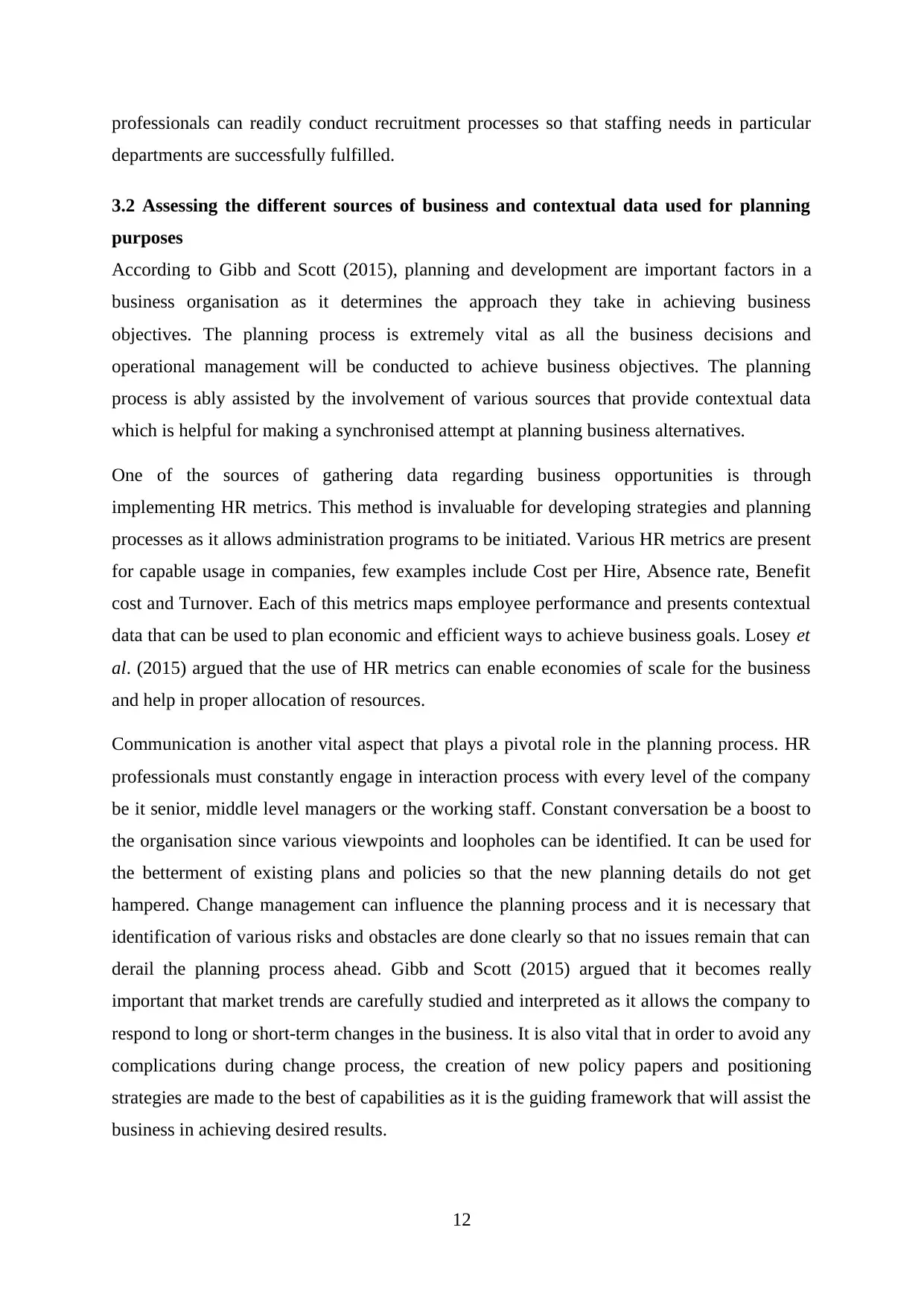
professionals can readily conduct recruitment processes so that staffing needs in particular
departments are successfully fulfilled.
3.2 Assessing the different sources of business and contextual data used for planning
purposes
According to Gibb and Scott (2015), planning and development are important factors in a
business organisation as it determines the approach they take in achieving business
objectives. The planning process is extremely vital as all the business decisions and
operational management will be conducted to achieve business objectives. The planning
process is ably assisted by the involvement of various sources that provide contextual data
which is helpful for making a synchronised attempt at planning business alternatives.
One of the sources of gathering data regarding business opportunities is through
implementing HR metrics. This method is invaluable for developing strategies and planning
processes as it allows administration programs to be initiated. Various HR metrics are present
for capable usage in companies, few examples include Cost per Hire, Absence rate, Benefit
cost and Turnover. Each of this metrics maps employee performance and presents contextual
data that can be used to plan economic and efficient ways to achieve business goals. Losey et
al. (2015) argued that the use of HR metrics can enable economies of scale for the business
and help in proper allocation of resources.
Communication is another vital aspect that plays a pivotal role in the planning process. HR
professionals must constantly engage in interaction process with every level of the company
be it senior, middle level managers or the working staff. Constant conversation be a boost to
the organisation since various viewpoints and loopholes can be identified. It can be used for
the betterment of existing plans and policies so that the new planning details do not get
hampered. Change management can influence the planning process and it is necessary that
identification of various risks and obstacles are done clearly so that no issues remain that can
derail the planning process ahead. Gibb and Scott (2015) argued that it becomes really
important that market trends are carefully studied and interpreted as it allows the company to
respond to long or short-term changes in the business. It is also vital that in order to avoid any
complications during change process, the creation of new policy papers and positioning
strategies are made to the best of capabilities as it is the guiding framework that will assist the
business in achieving desired results.
12
departments are successfully fulfilled.
3.2 Assessing the different sources of business and contextual data used for planning
purposes
According to Gibb and Scott (2015), planning and development are important factors in a
business organisation as it determines the approach they take in achieving business
objectives. The planning process is extremely vital as all the business decisions and
operational management will be conducted to achieve business objectives. The planning
process is ably assisted by the involvement of various sources that provide contextual data
which is helpful for making a synchronised attempt at planning business alternatives.
One of the sources of gathering data regarding business opportunities is through
implementing HR metrics. This method is invaluable for developing strategies and planning
processes as it allows administration programs to be initiated. Various HR metrics are present
for capable usage in companies, few examples include Cost per Hire, Absence rate, Benefit
cost and Turnover. Each of this metrics maps employee performance and presents contextual
data that can be used to plan economic and efficient ways to achieve business goals. Losey et
al. (2015) argued that the use of HR metrics can enable economies of scale for the business
and help in proper allocation of resources.
Communication is another vital aspect that plays a pivotal role in the planning process. HR
professionals must constantly engage in interaction process with every level of the company
be it senior, middle level managers or the working staff. Constant conversation be a boost to
the organisation since various viewpoints and loopholes can be identified. It can be used for
the betterment of existing plans and policies so that the new planning details do not get
hampered. Change management can influence the planning process and it is necessary that
identification of various risks and obstacles are done clearly so that no issues remain that can
derail the planning process ahead. Gibb and Scott (2015) argued that it becomes really
important that market trends are carefully studied and interpreted as it allows the company to
respond to long or short-term changes in the business. It is also vital that in order to avoid any
complications during change process, the creation of new policy papers and positioning
strategies are made to the best of capabilities as it is the guiding framework that will assist the
business in achieving desired results.
12
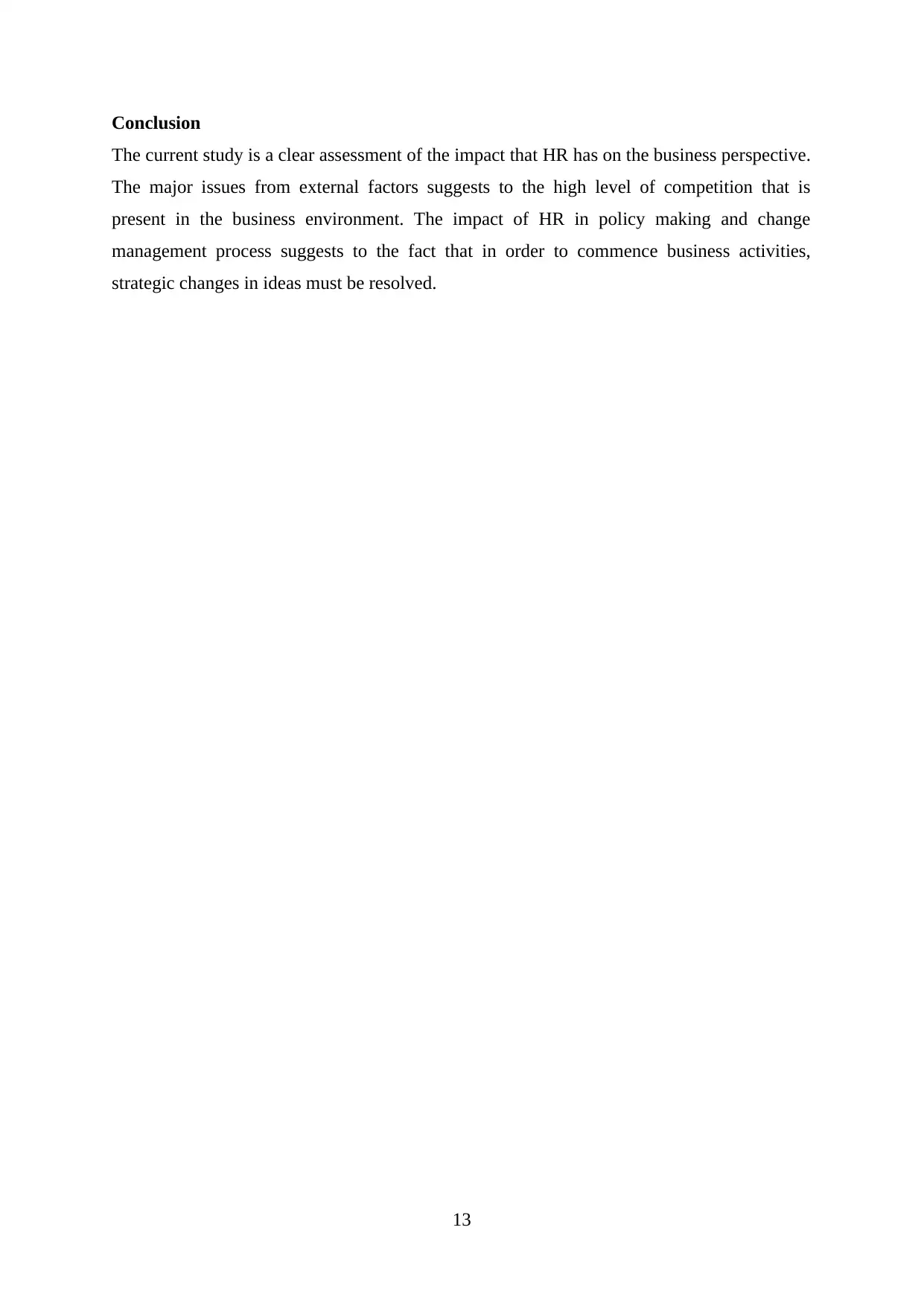
Conclusion
The current study is a clear assessment of the impact that HR has on the business perspective.
The major issues from external factors suggests to the high level of competition that is
present in the business environment. The impact of HR in policy making and change
management process suggests to the fact that in order to commence business activities,
strategic changes in ideas must be resolved.
13
The current study is a clear assessment of the impact that HR has on the business perspective.
The major issues from external factors suggests to the high level of competition that is
present in the business environment. The impact of HR in policy making and change
management process suggests to the fact that in order to commence business activities,
strategic changes in ideas must be resolved.
13
Paraphrase This Document
Need a fresh take? Get an instant paraphrase of this document with our AI Paraphraser
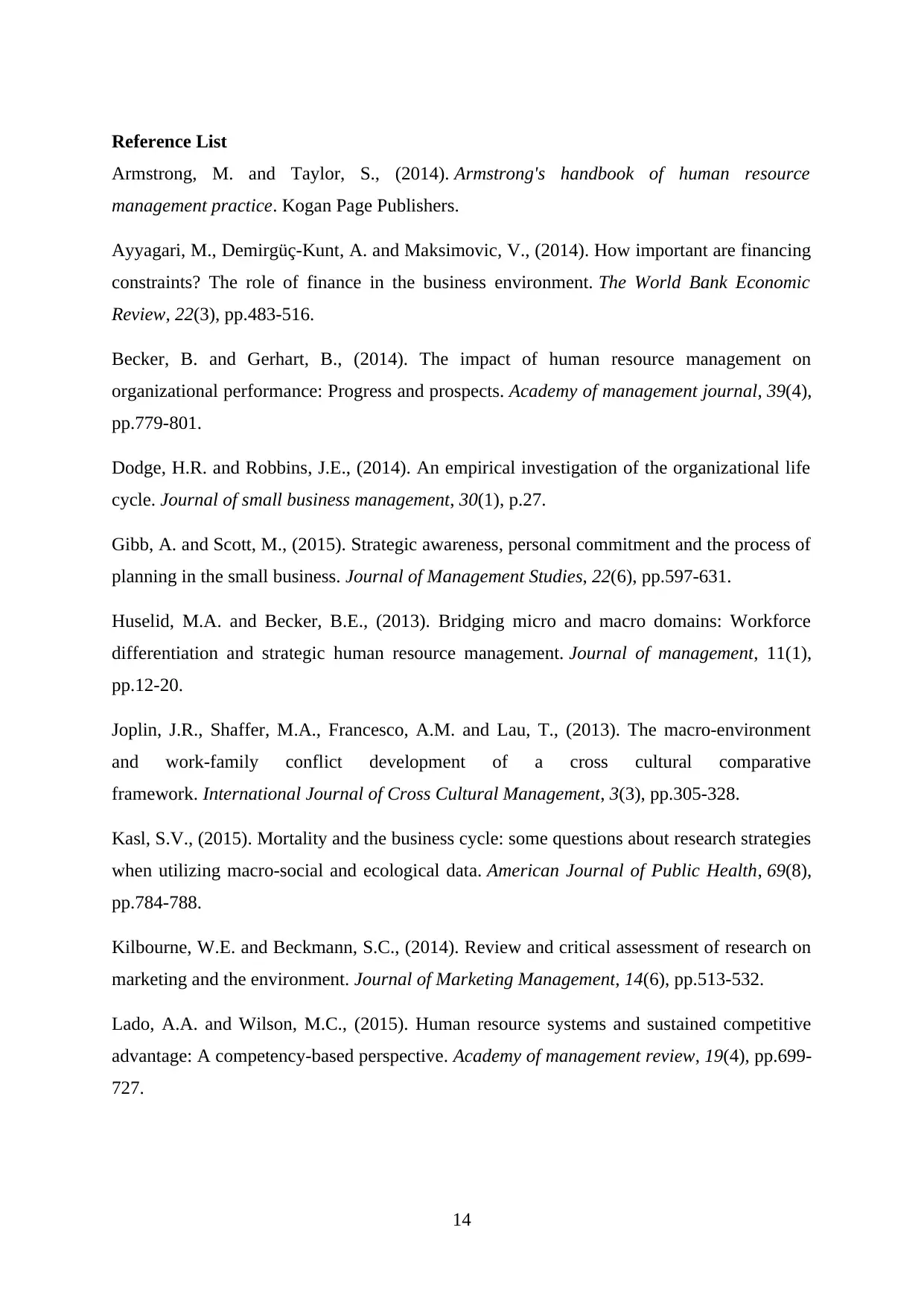
Reference List
Armstrong, M. and Taylor, S., (2014). Armstrong's handbook of human resource
management practice. Kogan Page Publishers.
Ayyagari, M., Demirgüç-Kunt, A. and Maksimovic, V., (2014). How important are financing
constraints? The role of finance in the business environment. The World Bank Economic
Review, 22(3), pp.483-516.
Becker, B. and Gerhart, B., (2014). The impact of human resource management on
organizational performance: Progress and prospects. Academy of management journal, 39(4),
pp.779-801.
Dodge, H.R. and Robbins, J.E., (2014). An empirical investigation of the organizational life
cycle. Journal of small business management, 30(1), p.27.
Gibb, A. and Scott, M., (2015). Strategic awareness, personal commitment and the process of
planning in the small business. Journal of Management Studies, 22(6), pp.597-631.
Huselid, M.A. and Becker, B.E., (2013). Bridging micro and macro domains: Workforce
differentiation and strategic human resource management. Journal of management, 11(1),
pp.12-20.
Joplin, J.R., Shaffer, M.A., Francesco, A.M. and Lau, T., (2013). The macro-environment
and work-family conflict development of a cross cultural comparative
framework. International Journal of Cross Cultural Management, 3(3), pp.305-328.
Kasl, S.V., (2015). Mortality and the business cycle: some questions about research strategies
when utilizing macro-social and ecological data. American Journal of Public Health, 69(8),
pp.784-788.
Kilbourne, W.E. and Beckmann, S.C., (2014). Review and critical assessment of research on
marketing and the environment. Journal of Marketing Management, 14(6), pp.513-532.
Lado, A.A. and Wilson, M.C., (2015). Human resource systems and sustained competitive
advantage: A competency-based perspective. Academy of management review, 19(4), pp.699-
727.
14
Armstrong, M. and Taylor, S., (2014). Armstrong's handbook of human resource
management practice. Kogan Page Publishers.
Ayyagari, M., Demirgüç-Kunt, A. and Maksimovic, V., (2014). How important are financing
constraints? The role of finance in the business environment. The World Bank Economic
Review, 22(3), pp.483-516.
Becker, B. and Gerhart, B., (2014). The impact of human resource management on
organizational performance: Progress and prospects. Academy of management journal, 39(4),
pp.779-801.
Dodge, H.R. and Robbins, J.E., (2014). An empirical investigation of the organizational life
cycle. Journal of small business management, 30(1), p.27.
Gibb, A. and Scott, M., (2015). Strategic awareness, personal commitment and the process of
planning in the small business. Journal of Management Studies, 22(6), pp.597-631.
Huselid, M.A. and Becker, B.E., (2013). Bridging micro and macro domains: Workforce
differentiation and strategic human resource management. Journal of management, 11(1),
pp.12-20.
Joplin, J.R., Shaffer, M.A., Francesco, A.M. and Lau, T., (2013). The macro-environment
and work-family conflict development of a cross cultural comparative
framework. International Journal of Cross Cultural Management, 3(3), pp.305-328.
Kasl, S.V., (2015). Mortality and the business cycle: some questions about research strategies
when utilizing macro-social and ecological data. American Journal of Public Health, 69(8),
pp.784-788.
Kilbourne, W.E. and Beckmann, S.C., (2014). Review and critical assessment of research on
marketing and the environment. Journal of Marketing Management, 14(6), pp.513-532.
Lado, A.A. and Wilson, M.C., (2015). Human resource systems and sustained competitive
advantage: A competency-based perspective. Academy of management review, 19(4), pp.699-
727.
14
1 out of 14
Related Documents
Your All-in-One AI-Powered Toolkit for Academic Success.
+13062052269
info@desklib.com
Available 24*7 on WhatsApp / Email
![[object Object]](/_next/static/media/star-bottom.7253800d.svg)
Unlock your academic potential
© 2024 | Zucol Services PVT LTD | All rights reserved.





